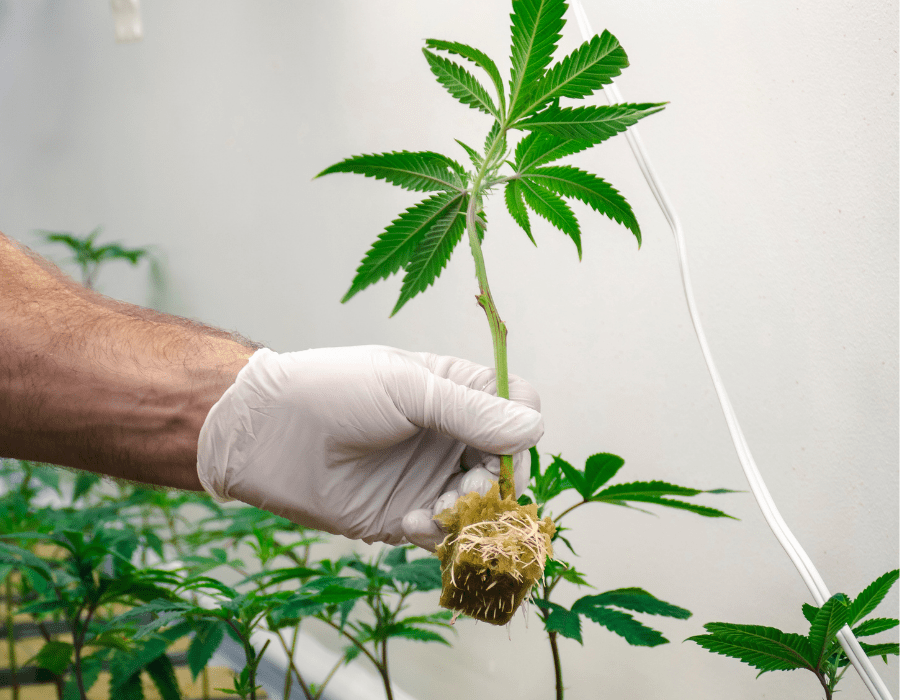If you have ever encountered mushrooms growing in your cannabis garden, you may have contemplated whether the sprouting objects are friend or foe. Obviously, the warm, humid growing environment must be inviting as the fungal protrusions begin popping up from beneath the soil. But are mushrooms good to be growing alongside your marijuana plants?
When we think of fungi in cannabis cultivation, often the first thought is dread. Mould spores multiply prolifically under ideal conditions in most grow rooms. High temperatures and sultry humidity levels encourage botrytis and other malignant fungal spores to reproduce. Without immediate intervention, these deadly fungi can quickly decimate a cannabis crop.
While some fungal species are detrimental in a marijuana garden, others provide mutual support to the plants. A valuable symbiotic relationship exists between beneficial fungi and cannabis plant roots called mycorrhizae. In this advantageous interaction, the plant feeds the hungry fungi, which in turn supports plant development.
Mycorrhizae relationships have existed for millions of years between various plant species and fungi. One example is mushrooms protruding out of decaying logs in a thick forest. The mushrooms are the ‘fruiting’ bodies of the fungi, encouraged to spawn by the symbiotic platform of the environment.
Interestingly, advanced research into marijuana cultivation unveils the benefits of mycorrhizae fungi on plants in several different ways. Not only does fungi support and contribute to a plant’s root system, but it also helps with nutrient and water uptake, disease resistance, and environmental impacts.
Checkin’ Out the Root Zone
If you have ever flipped a marijuana plant upside down and slid the pot off to survey root growth, a healthy white system of large, sturdy roots should be dominantly observed. However, taking a closer look at the pearly white tentacles exposes fuzzy little components called hyphae intertwined into a complex web of support.
This hyphae branching, referred to as mycelium, results from the mycorrhizal relationship between the cannabis plant’s root system and the fungus spores germinated from their collaboration. As the plant matures through its life cycle, the root system becomes an increasingly complex array of large roots with the smaller threads from the hyphae weaved amongst them.
By the time a mycorrhizal happy potted plant is ready for harvest, the root ball is often so dense, you can cut it with a knife.
How Does Fungus Help a Marijuana Plant?
Fungi is a basic life form dating back to the beginning of time found in many natural practices. Generally, the fungus is known for its decomposition activities of organic matter and assistance with yeast and fermentation reactions.
In the plant world, fungi play a huge role in aiding the root system. As hospitable hosts, mycorrhizal relations develop in a plant’s root zone to encourage fungal interaction. The roots provide the essential sugar molecules for fungi to survive while, in return, hyphae filaments spread throughout the system, building a supportive mycelium network.
Thin hyphal strands reach out far and wide to extract essential nutrients and water in the substrate. As the surface area of the root zone expands from their influence, uptake of these vital lifelines also increases. In addition, fungi build small reservoirs to increase the root zone’s water holding capacity while creating branching structures called arbuscules to exchange nutrients for sugar molecules.
As an added bonus, the mycelium branching becomes a fortress, protecting a marijuana plant’s root system from pathogens such as botrytis. With the help of fungi in a mycorrhizal relationship, plants become more resistant to environmental stresses such as drought or toxicity from excess salts or unwanted heavy metal particles.
Further enhancing the symbiosis, fungi excrete metabolic by-products containing glomalin which binds soil particles together. The presence of this glycoprotein results in better water retention, less erosion, and overall improvements to soil quality.
